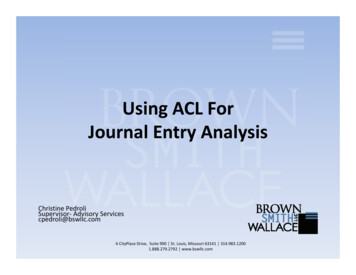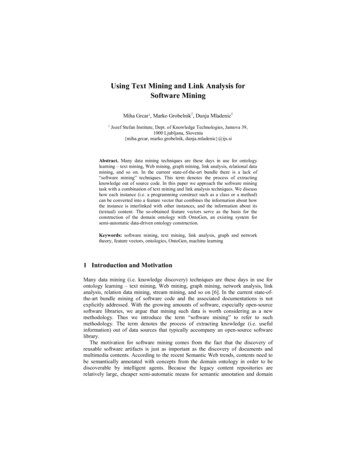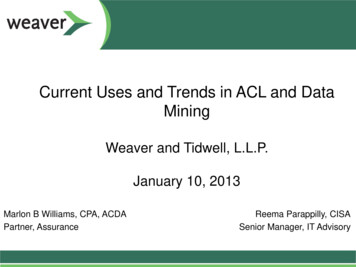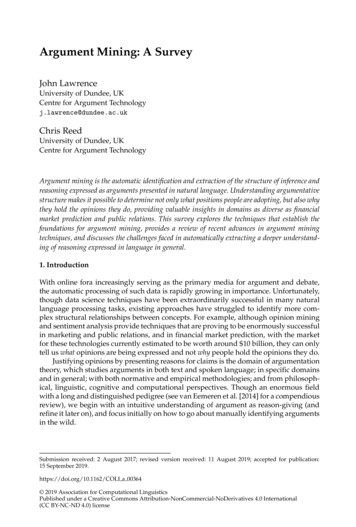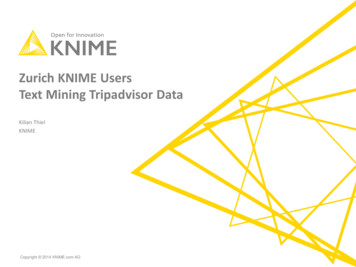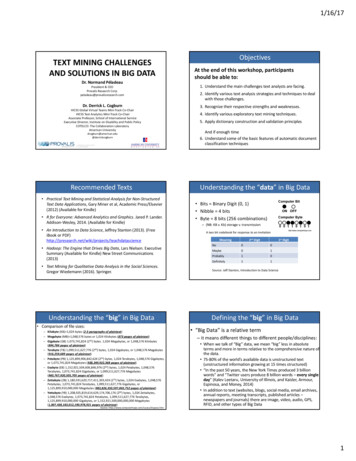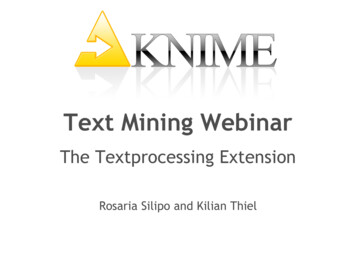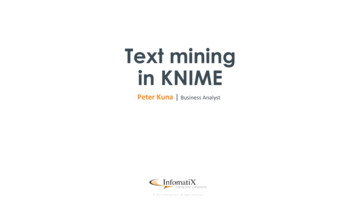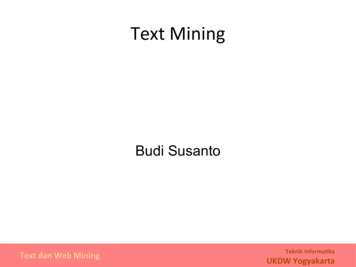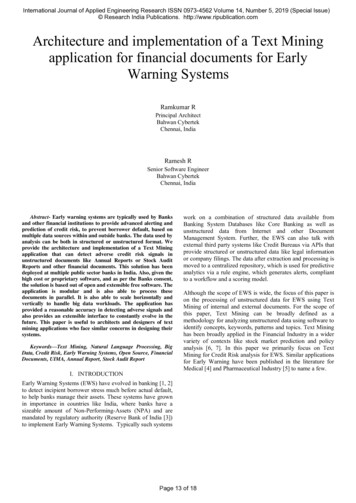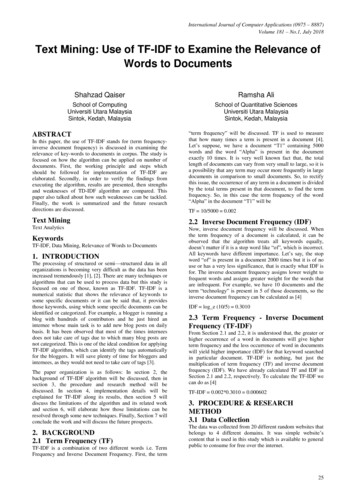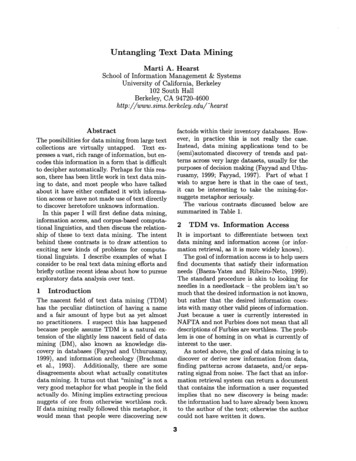
Transcription
Untangling Text Data MiningMarti A. HearstSchool of Information M a n a g e m e n t & SystemsUniversity of California, Berkeley102 South HallBerkeley, CA 94720-4600http ://www. sims. berkeley, edu/-hearstAbstractfactoids within their inventory databases. However, in practice this is not really the case.Instead, data mining applications tend to be(semi)automated discovery of trends and patterns across very large datasets, usually for thepurposes of decision making (Fayyad and Uthurusamy, 1999; Fayyad, 1997). Part of what Iwish to argue here is that in the case of text,it can be interesting to take the mining-fornuggets metaphor seriously.The various contrasts discussed below aresummarized in Table 1.The possibilities for data mining from large textcollections are virtually untapped. Text expresses a vast, rich range of information, but encodes this information in a form that is difficultto decipher automatically. Perhaps for this reason, there has been little work in text data mining to date, and most people who have talkedabout it have either conflated it with information access or have not made use of text directlyto discover heretofore unknown information.In this paper I will first define data mining,information access, and corpus-based computational linguistics, and then discuss the relationship of these to text data mining. The intentbehind these contrasts is to draw attention toexciting new kinds of problems for computational linguists. I describe examples of what Iconsider to be reM text data mining efforts andbriefly outline recent ideas about how to pursueexploratory data analysis over text.2TDMvs. I n f o r m a t i o n A c c e s sIt is important to differentiate between textdata mining and information access (or information retrieval, as it is more widely known).The goal of information access is to help usersfind documents that satisfy their informationneeds (Baeza-Yates and Ribeiro-Neto, 1999).The standard procedure is akin to looking forneedles in a needlestack - the problem isn't somuch that the desired information is not known,but rather that the desired information coexists with many other valid pieces of information.Just because a user is currently interested inNAFTA and not Furbies does not mean that alldescriptions of Furbies are worthless. The problem is one of homing in on what is currently ofinterest to the user.As noted above, the goal of data mining is todiscover or derive new information from data,finding patterns across datasets, and/or separating signal from noise. The fact that an information retrieval system can return a documentthat contains the information a user requestedimplies that no new discovery is being made:the information had to have already been knownto the author of the text; otherwise the authorcould not have written it down.IntroductionThe nascent field of text data mining (TDM)has the peculiar distinction of having a nameand a fair amount of hype but as yet almostno practitioners. I suspect this has happenedbecause people assume TDM is a natural extension of the slightly less nascent field of datamining (DM), also known as knowledge discovery in databases (Fayyad and Uthurusamy,1999), and information archeology (Brachmanet al., 1993). Additionally, there are somedisagreements about what actually constitutesdata mining. It turns out that "mining" is not avery good metaphor for what people in the fieldactually do. Mining implies extracting preciousnuggets of ore from otherwise worthless rock.If data mining really followed this metaphor, itwould mean that people were discovering new13
I have observed that many people, whenasked about text data mining, assume it shouldhave something to do with "making things easier to find on the web". For example, the description of the KDD-97 panel on Data Miningand the Web stated:. Two challenges are predominant fordata mining on the Web. The first goal isto help users in finding useful informationon the Web and in discovering knowledgeabout a domain that is represented by acollection of Web-documents. The secondgoal is to analyse the transactions run ina Web-based system, be it to optimize thesystem or to find information about theclients using the system. 1This search-centric view misses the point thatwe might actually want to treat the informationin the web as a large knowledge base from whichwe can extract new, never-before encounteredinformation (Craven et al., 1998).On the other hand, the results of certain typesof text processing can yield tools that indirectlyaid in the information access process. Examples include text clustering to create thematicoverviews of text collections (Cutting et al.,1992; Chalmers and Chitson, 1992; Rennison,1994; Wise et al., 1995; Lin et al., 1991; Chenet al., 1998), automatically generating term associations to aid in query expansion (Peat andWillett, 1991; Voorhees, 1994; Xu and Croft,1996), and using co-citation analysis to find general topics within a collection or identify centralweb pages (White and McCain, 1989; Larson,1996; Kleinberg, 1998).Aside from providing tools to aid in the standard information access process, I think textdata mining can contribute along another dimension. In future I hope to see informationaccess systems supplemented with tools for exploratory data analysis. Our efforts in this direction are embodied in the LINDI project, described in Section 5 below.exists a field engaged in text data mining:corpus-based computational linguistics! Empirical computational linguistics computes statistics over large text collections in order to discover useful patterns. These patterns are usedto inform algorithms for various subproblemswithin natural language processing, such aspart-of-speech tagging, word sense disambiguation, and bilingual dictionary creation (Armstrong, 1994).It is certainly of interest to a computationallinguist that the words "prices, prescription,and patent" are highly likely to co-occur withthe medical sense of "drug" while "abuse, paraphernalia, and illicit" are likely to co-occur withthe illegal drug sense of this word (Church andLiberman, 1991). This kind of information canalso be used to improve information retrieval algorithms. However, the kinds of patterns foundand used in computational linguistics are notlikely to be what the general business community hopes for when they use the term text datamining.Within the computational linguistics framework, efforts in automatic augmentation of existing lexical structures seem to fit the datamining-as-ore-extraction metaphor. Examplesinclude automatic augmentation of WordNet relations (Fellbaum, 1998) by identifying lexicosyntactic patterns that unambiguously indicatethose relations (Hearst, 1998), and automaticacquisition of subcategorization data from largetext corpora (Manning, 1993). However, theseserve the specific needs of computational linguistics and are not applicable to a broader audience.4TDMand CategoryMetadataSome researchers have claimed that text categorization should be considered text data mining. Although analogies can be found in thedata mining literature (e.g., referring to classification of astronomical phenomena as data mining (Fayyad and Uthurusamy, 1999)), I believe3 TDM and Computationalwhenapplied to text categorization this is a misLinguisticsnomer. Text categorization is a boiling down ofIf we extrapolate from data mining (as practhe specific content of a document into one (orticed) on numerical data to data mining frommore) of a set of pre-defined labels. This doestext collections, we discover that there alreadynot lead to discovery of new information; prel http: / /www.aaai.org/Conferences/ KD D/1997 /kdd97- sumably the person who wrote the documentknew what it was about. Rather, it produces aschedule.html4
Non-textual dataTextual dataFinding PatternsFinding Nuggetsstandard d a t a miningcomputational linguisticsNovelINon-Novel?database queriesreal T D M information retrievalTable 1: A classification of d a t a mining and text d a t a mining applications.compact s u m m a r y of something t h a t is alreadyknown.However, there are two recent areas of inquiry that make use of text categorization anddo seem to fit within the conceptual frameworkof discovery of trends and patterns within textual d a t a for more general purpose usage.One body of work uses text category labels(associated with Reuters newswire) to find "unexpected patterns" among text articles (Feldman and Dagan, 1995; Dagan et al., 1996; Feldman et al., 1997). The main approach is tocompare distributions of category assignmentswithin subsets of the document collection. Forinstance, distributions of commodities in country C1 are compared against those of countryC2 to see if interesting or unexpected trendscan be found. Extending this idea, one country's export trends might be compared againstthose of a set of countries that are seen as aneconomic unit (such as the G-7).Another effort is t h a t of the DARPA TopicDetection and Tracking initiative (Allan etal., 1998). While several of the tasks withinthis initiative are standard text analysis problems (such as categorization and segmentation),there is an interesting task called On-line NewEvent Detection, whose input is a stream ofnews stories in chronological order, and whoseoutput is a yes/no decision for each story, madeat the time the story arrives, indicating whetherthe story is the first reference to a newly occurring event. In other words, the system mustdetect the first instance of what will become a series of reports on some important topic. Although this can be viewed as a standard classification task (where the class is a binary assignment to the new-event class) it is more inthe spirit of d a t a mining, in that the focus ison discovery of the beginning of a new t h e m e ortrend.The reason I consider this examples - usingmultiple occurrences of text categories to detect trends or patterns - to be "real" d a t a min-ing is that t h e y use text m e t a d a t a to tell ussomething about the world, outside of the textcollection itself. (However, since this application uses m e t a d a t a associated with text documents, rather t h a n the text directly, it is unclear if it should be considered text d a t a mining or standard d a t a mining.) The computational linguistics applications tell us about howto improve language analysis, but t h e y do notdiscover more widely usable information.5T e x t D a t a M i n i n g as E x p l o r a t o r yData AnalysisAnother way to view text d a t a mining is asa process of exploratory d a t a analysis (Tukey,1977; Hoaglin et al., 1983) t h a t leads to the discovery of heretofore unknown information, orto answers for questions for which the answer isnot currently known.Of course, it can be argued t h a t the standard practice of reading textbooks, journal articles and other documents helps researchers inthe discovery of new information, since this isan integral part of the research process. However, the idea here is to use text for discoveryin a more direct manner. Two examples are described below.5.1U s i n g T e x t t o F o r m Hypothesesa b o u t DiseaseFor more t h a n a decade, Don Swanson has eloquently argued why it is plausible to expectnew information to be derivable from text collections: experts can only read a small subsetof what is published in their fields and are often unaware of developments in related fields.Thus it should be possible to find useful linkages between information in related literatures,if the authors of those literatures rarely refer toone another's work. Swanson has shown howchains of causal implication within the medicalliterature can lead to hypotheses for causes ofrare diseases, some of which have received supporting experimental evidence (Swanson, 1987;5
Swanson, 1991; Swanson and Smalheiser, 1994;Swanson and Smalheiser, 1997).For example, when investigating causes of migraine headaches, he extracted various pieces ofevidence from titles of articles in the biomedical literature. Some of these clues can be paraphrased as follows:5.2Using Text to Uncover SocialImpactSwitching to an entirely different domain, consider a recent effort to determine the effectsof publicly financed research on industrial advances (Narin et al., 1997). After years ofpreliminary studies and building special purpose tools, the authors found t h a t the technology industry relies more heavily than everon government-sponsored research results. Theauthors explored relationships among patenttext and the published research literature, using a procedure which was reported as followsin Broad (1997): stress is associated with migraines stress can lead to loss of magnesium calcium channel blockers prevent some migraines magnesium is a natural calcium channelblockerThe CHI Research team examined thescience references on the front pages ofAmerican patents in two recent periods 1987 and 1988, as well as 1993 and 1994 looking at all the 397,660 patents issued.It found 242,000 identifiable science references and zeroed in on those publishedin the preceding 11 years, which turnedout to be 80 percent of them. Searches ofcomputer databases allowed the linking of109,000 of these references to known journals and authors' addresses. After eliminating redundant citations to the samepaper, as well as articles with no knownAmerican author, the study had a core collection of 45,000 papers. Armies of aidesthen fanned out to libraries to look upthe papers and examine their closing lines,which often say who financed the research.That detective work revealed an extensivereliance on publicly financed science. spreading cortical depression (SCD) is implicated in some migraines high leveles of magnesium inhibit SCD migraine patients have high platelet aggregability magnesium c a n suppress platelet aggregabilityThese clues suggest that magnesium deficiency m a y play a role in some kinds of migraine headache; a hypothesis which did not exist in the literature at the time Swanson foundthese links. The hypothesis has to be tested vianon-textual means, b u t the important point isthat a new, potentially plausible medical hypothesis was derived from a combination oftext fragments and the explorer's medical expertise. (According to Swanson (1991), subsequent s t u d y found support for the magnesiummigraine hypothesis ( R a m a d a n et al., 1989).)This approach has been only partially automated. There is, of course, a potential for combinatorial explosion of potentially valid links.Beeferman (1998) has developed a flexible interface and analysis tool for exploring certainkinds of chains of links among lexical relationswithin WordNet. 2 However, sophisticated newalgorithms are needed for helping in the pruning process, since a good pruning algorithm willwant to take into account various kinds of semantic constraints. This m a y be an interesting area of investigation for computational linguists.Further narrowing its focus, the study setaside patents given to schools and governments and zeroed in on those awarded toindustry. For 2,841 patents issued in 1993and 1994, it examined the peak year of literature references, 1988, and found 5,217citations to science papers.Of these, it found that 73.3 percent hadbeen written at public institutions - universities, government labs and other public agencies, both in the United States andabroad.Thus a heterogeneous mix of operations wasrequired to conduct a complex analyses overlarge text collections.These operations included:2See http://www.link.cs.cmu.edu/lexfn6
1 Retrieval of articles from a particular collection (patents) within a particular daterange.2 Identification of the citation pool (articlescited by the patents).3 Bracketing of this pool by date, creating anew subset of articles.4 Computation of the percentage of articlesthat remain after bracketing.5 Joining these results with those of othercollections to identify the publishers of articles in the pool.6 Elimination of redundant articles.7 Elimination of articles based on an attribute type (author nationality).8 Location of full-text versions of the articles.9 Extraction of a special attribute from thefull text (the acknowledgement of funding).10 Classification of this attribute (by institution type).11 Narrowing the set of articles to consider byan attribute (institution type).12 Computation of statistics over one of theattributes (peak year)13 Computation of the percentage of articles for which one attribute has been assigned another attribute type (whose citation attribute has a particular institutionattribute).Because all the data was not available online,much of the work had to be done by hand, andspecial purpose tools were required to performthe operations.5.3 T h e L I N D I P r o j e c tThe objectives of the LINDI project 3 are to investigate how researchers can use large text collections in the discovery of new important information, and to build software systems to helpsupport this process. The main tools for discovering new information are of two types: support for issuing sequences of queries and relatedoperations across text collections, and tightlycoupled statistical and visualization tools forthe examination of associations among conceptsthat co-occur within the retrieved documents.Both sets of tools make use of attributes associated specifically with text collections and3LINDI: L i n k i n g I n f o r m a t i o n for Novel Discovery a n dInsight.their metadata. Thus the broadening, narrowing, and linking of relations seen in the patentexample should be tightly integrated with analysis and interpretation tools as needed in thebiomedical example.Following Amant (1996), the interactionparadigm is that of a mixed-initiative balanceof control between user and system. The interaction is a cycle in which the system suggestshypotheses and strategies for investigating thesehypotheses, and the user either uses or ignoresthese suggestions and decides on the next move.We are interested in an important problemin molecular biology, that of automating thediscovery of the function of newly sequencedgenes (Walker et al., 1998). Human genomeresearchers perform experiments in which theyanalyze co-expression of tens of thousands ofnovel and known genes simultaneously. 4 Giventhis huge collection of genetic information, thegoal is to determine which of the novel genesare medically interesting, meaning that theyare co-expressed with already understood geneswhich are known to be involved in disease. Ourstrategy is to explore the biomedical literature,trying to formulate plausible hypotheses aboutwhich genes are of interest.Most information access systems require theuser to execute and keep track of tactical moves,often distracting from the thought-intensive aspects of the problem (Bates, 1990). The LINDIinterface provides a facility for users to buildand so reuse sequences of query operations viaa drag-and-drop interface. These allow the userto repeat the same sequence of actions for different queries. In the gene example, this allows theuser to specify a sequence of operations to apply to one co-expressed gene, and then iteratethis sequence over a list of other co-expressedgenes that can be dragged onto the template.(The Visage interface (Derthick et al., 1997)implements this kind of functionality within itsinformation-centric framework.) These includethe following operations (see Figure 1): Iteration of an operation over the itemswithin a set. (This allows each item retrieved in a previous query to be use as a4A gene g co-expresses w i t h gene g w h e n b o t h aref o u n d to b e a c t i v a t e d in t h e s a m e cells a t t h e s a m e t i m ew i t h m u c h m o r e likelihood t h a n chance.
search terms for a new query.)6 Transformation, i.e., applying an operationto an item and returning a transformeditem (such as extracting a feature).Summary Reduction, i.e., applying an operation toone or more sets of items to yield
data mining literature (e.g., referring to classifi- cation of astronomical phenomena as data min- ing (Fayyad and Uthurusamy, 1999)), I believe when applied to text categorization this is a mis- nomer. Text categorization is a boiling down of the specific content of a document into one (or .Cited by: 1337Publish Year: 1999
